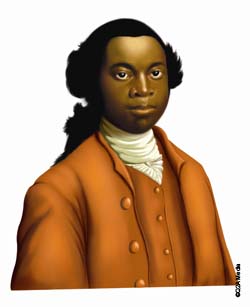Black History/Literacy: A journey through words
Add to My Folder
Look at identity and place in autobiographical writing using the spirited true story of Olaudah Equiano as a stimulus

The study of Olaudah Equiano’s autobiography will allow you to focus on personal journeys and their contexts, in all their manifestations – full autobiography, or a period during a life; an incident, or incidents; a personal struggle with a problem, or an actual journey to a particular place.
Olaudah Equiano’s autobiography encapsulates these and so much more – it unfolds a bigger picture, documenting one of the most monstrous and tragic periods in human history – the Trans-Atlantic slave trade. His story became a crucial witness in the move to eradicate the slave trade.
Essential facts
- Olaudah Equiano was born around 1745 and was the son of a respected elder in southern Nigeria. When he was about 11, he was captured by slavers and forced to endure the Trans-Atlantic crossing, first to Barbados and then to Virginia.
- He was sold as a slave to Lieutenant Michael Pascal, a Royal Navy Officer. Olaudah was beaten into accepting a new name – Gustavus Vassa.
- In the 1750s, Olaudah went to sea with Pascal, who brought him to England. Here, Olaudah was educated, interrupted by tough spells in the Royal Navy during the Seven Years’ War in France.
- He was taken to Monserrat, where he was sold to a Quaker Christian – Robert King. Olaudah was put in charge of weights and measures on a sugar plantation. Every day he witnessed the horrific treatment of slaves.
- By 1766, Olaudah had saved £40 – enough money to buy his freedom. He became a hairdresser in England.
- In 1773, Olaudah joined John Phipps in his quest to find a quick north-west passage to India. Olaudah met a young Horatio Nelson.
- Olaudah returned to England where he tried to stop his free friend, John Annis, from being reenslaved, which had been outlawed in 1772. Olaudah joined others, such as the scholar, Granville Sharp, in the Society for the Abolition of the Slave Trade.
- Olaudah became a Christian and helped to start a new plantation project on the Central American coast. Slave labour was still thought to be the only way of working the plantation economy. Many people against the slave trade, including Olaudah initially, were opposed more to the cruel treatment of slaves than to the slave system itself.
- Olaudah was employed as Commissary of Provisions and Stores for a new project setting up a colony of freed slaves in Sierra Leone. Some of those he dealt with were corrupt and the mission failed.
- In 1788, he encouraged a freed slave, Quobna Ottobah Cugoano, to publish his story of slavery.
- In 1789, Olaudah published his own autobiography, and travelled across Britain with it, tirelessly campaigning against the slave trade at the same time.
- In 1792, he married Susanna Cullen and had two daughters. Olaudah died in 1797.
- In 1807, the Trans-Atlantic slave trade was abolished on British ships. In 1833, slavery itself was abolished in Britain. In 1865, it was abolished in the US, although it continued in South America for more than 20 years after.
Scholastic Resource Bank: Primary - join today!
- Over 6,000 primary activities, lesson ideas and resources
- Perfect for anyone working with children from 5 to 11 years old
- Unlimited access from just £1.25 per month
Already a member? Sign in below.
Published 22 September 2008
Reviews
You need to be signed in to place a review.